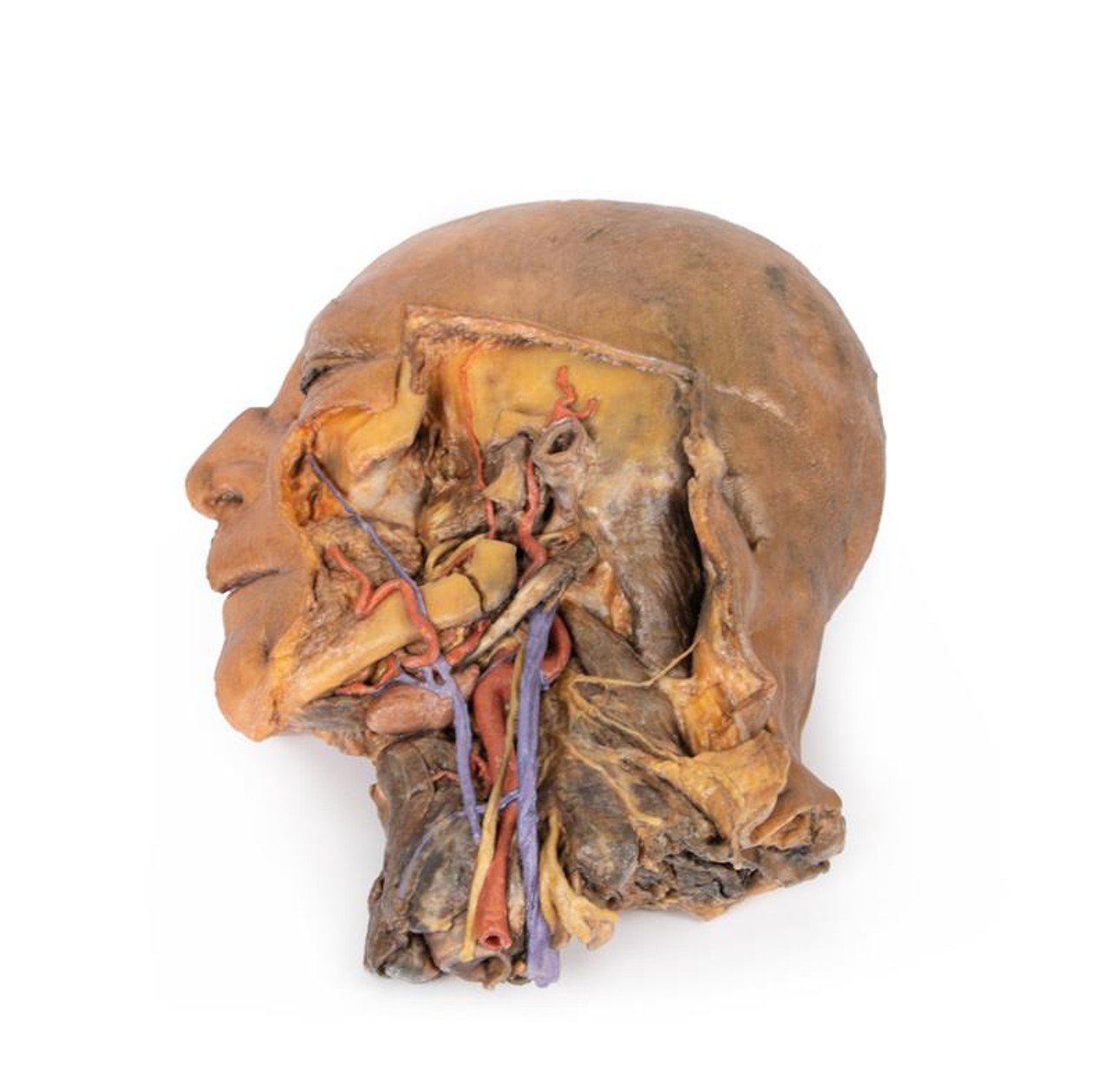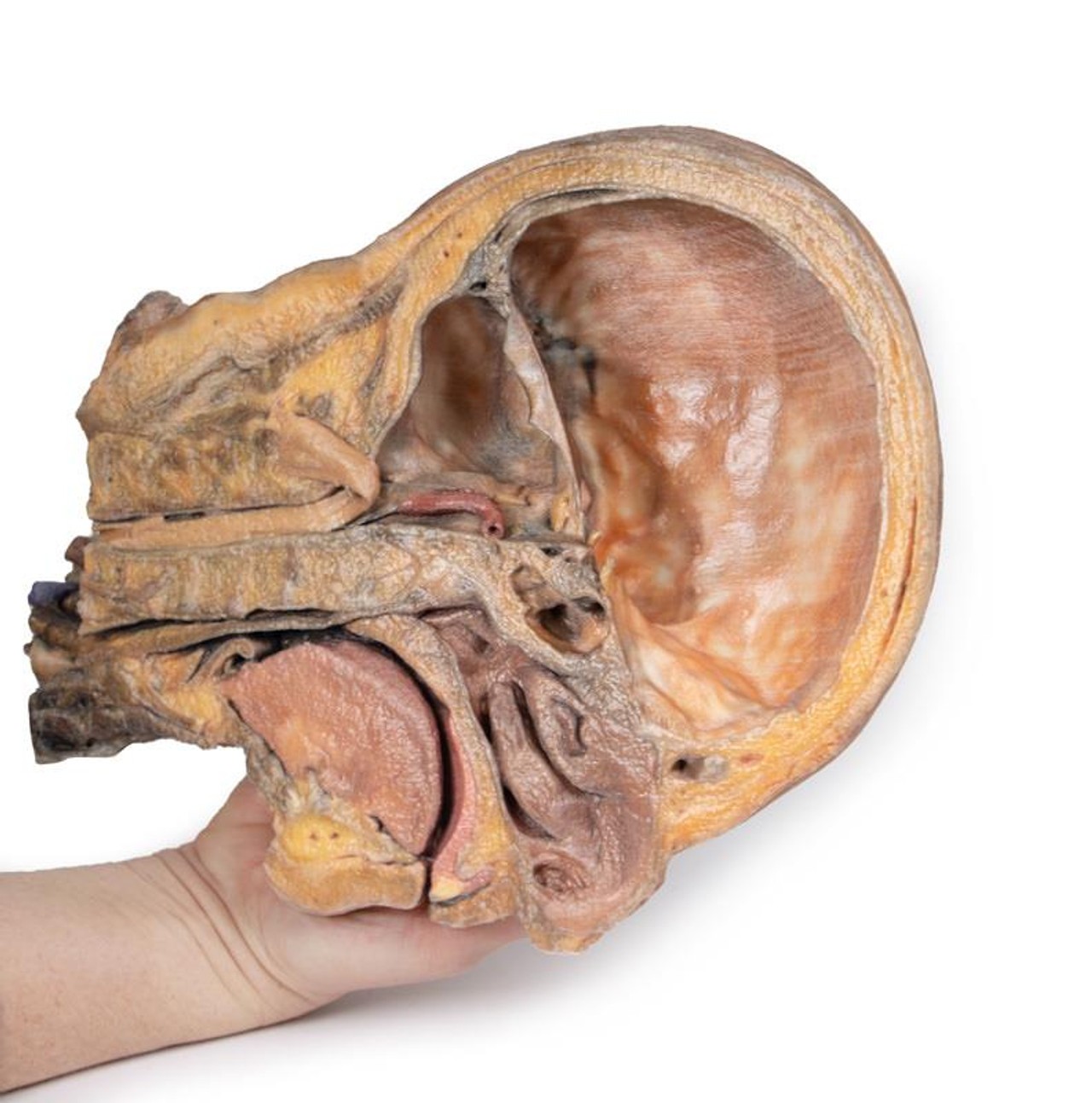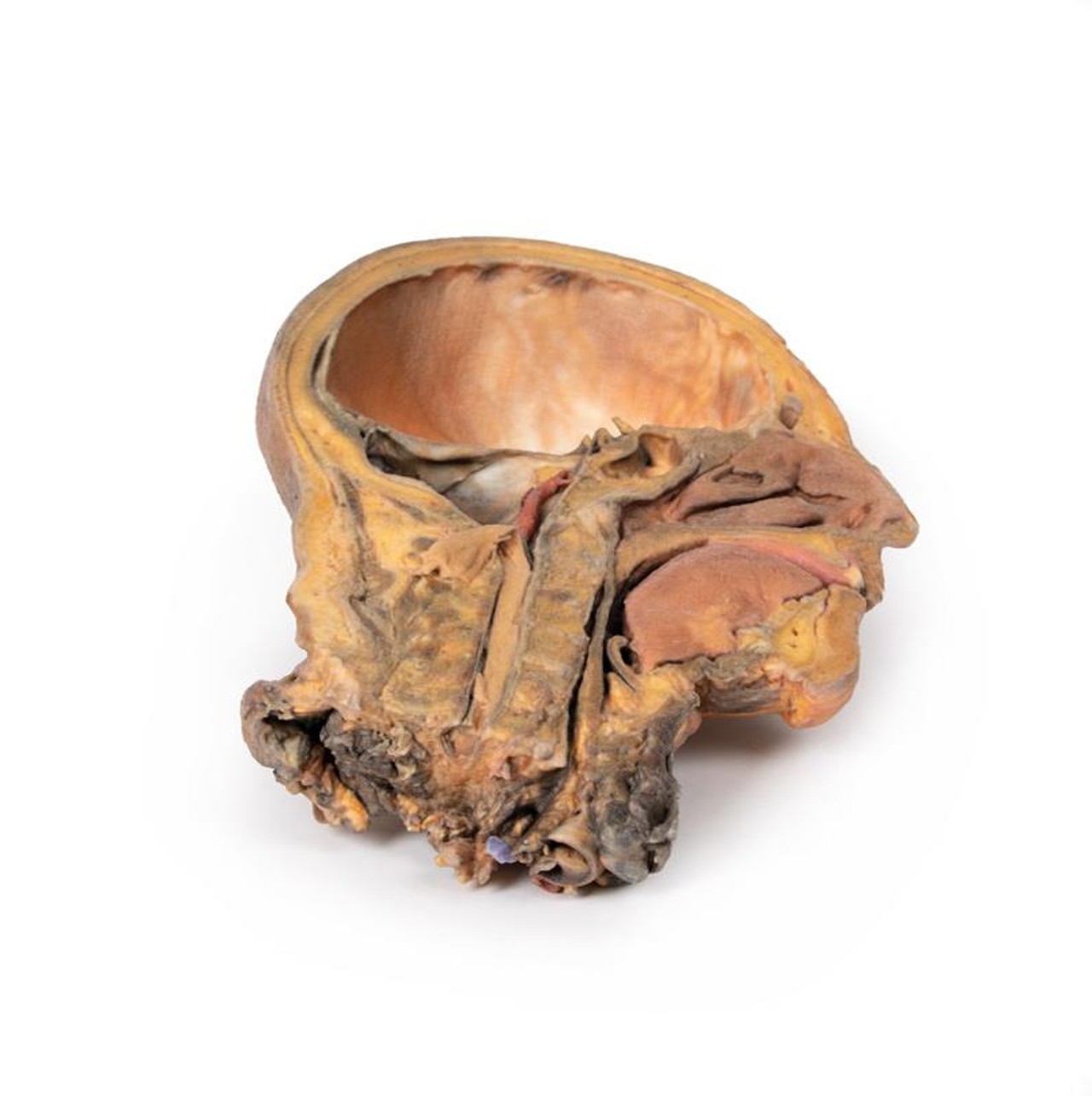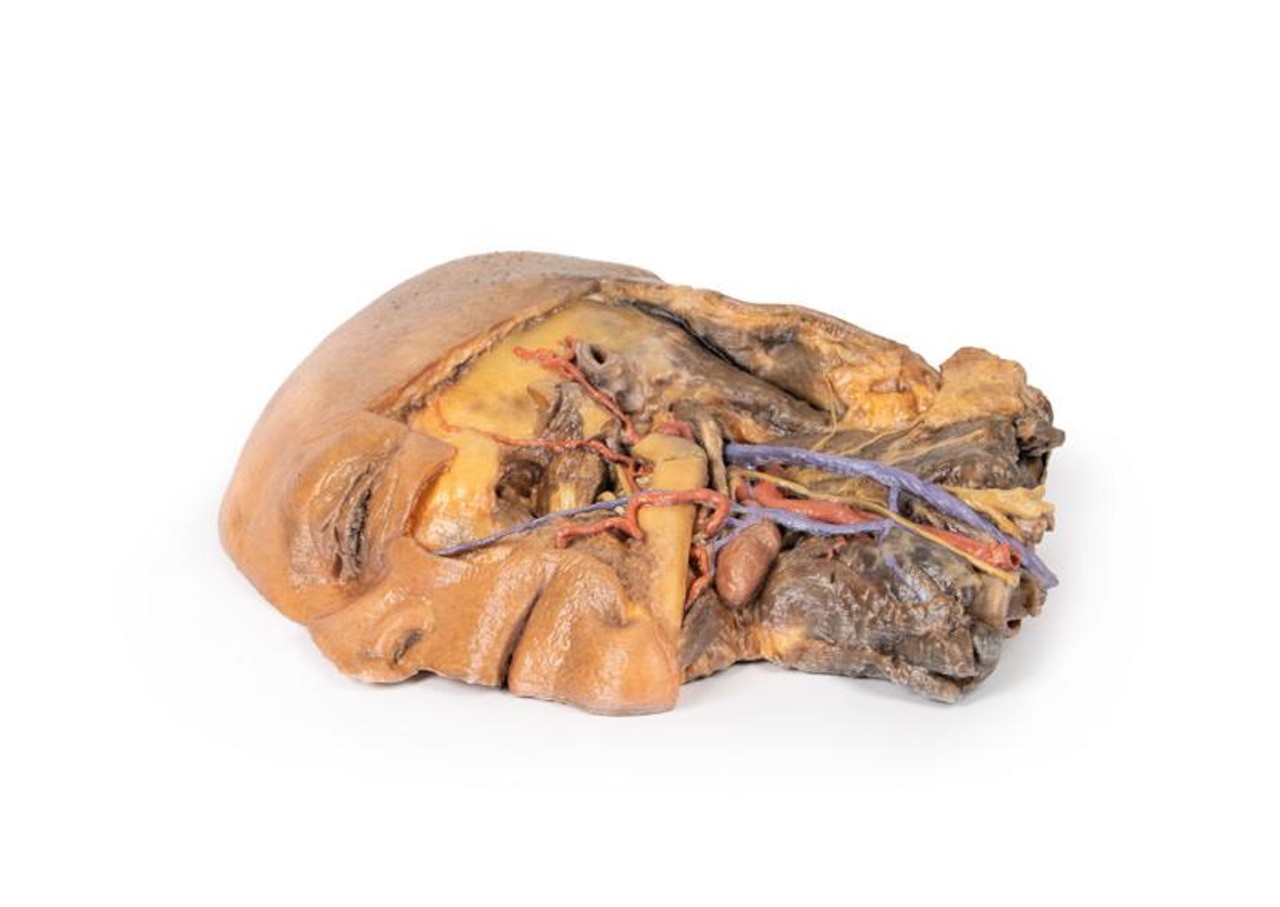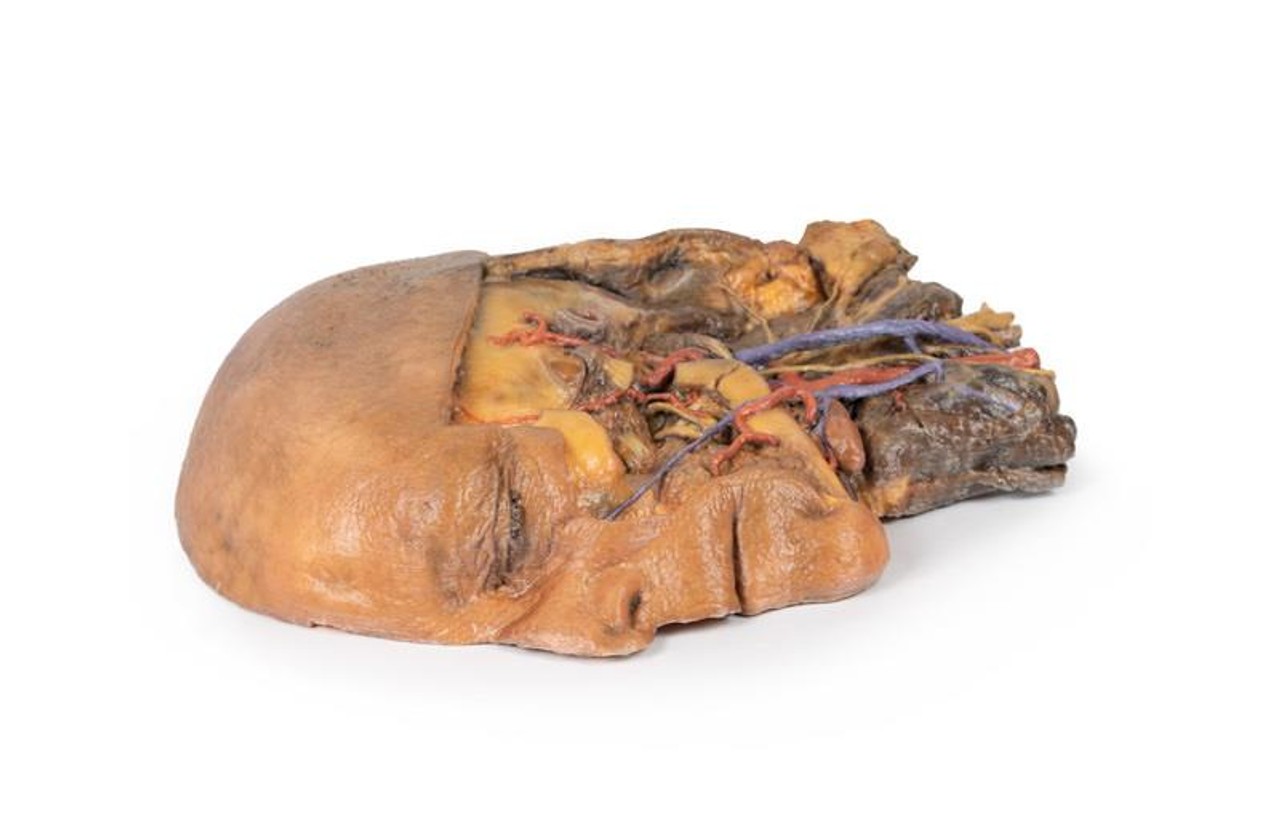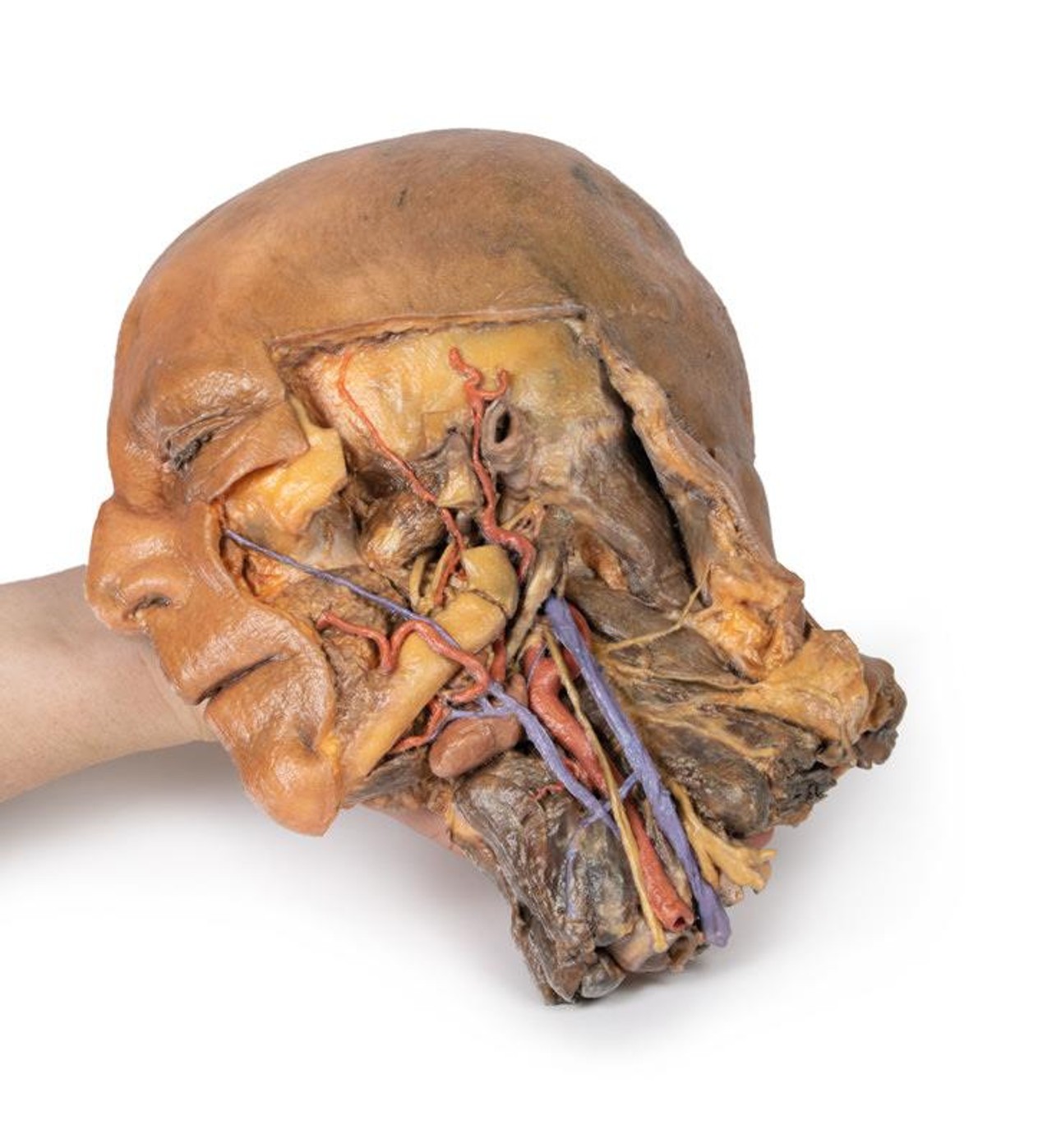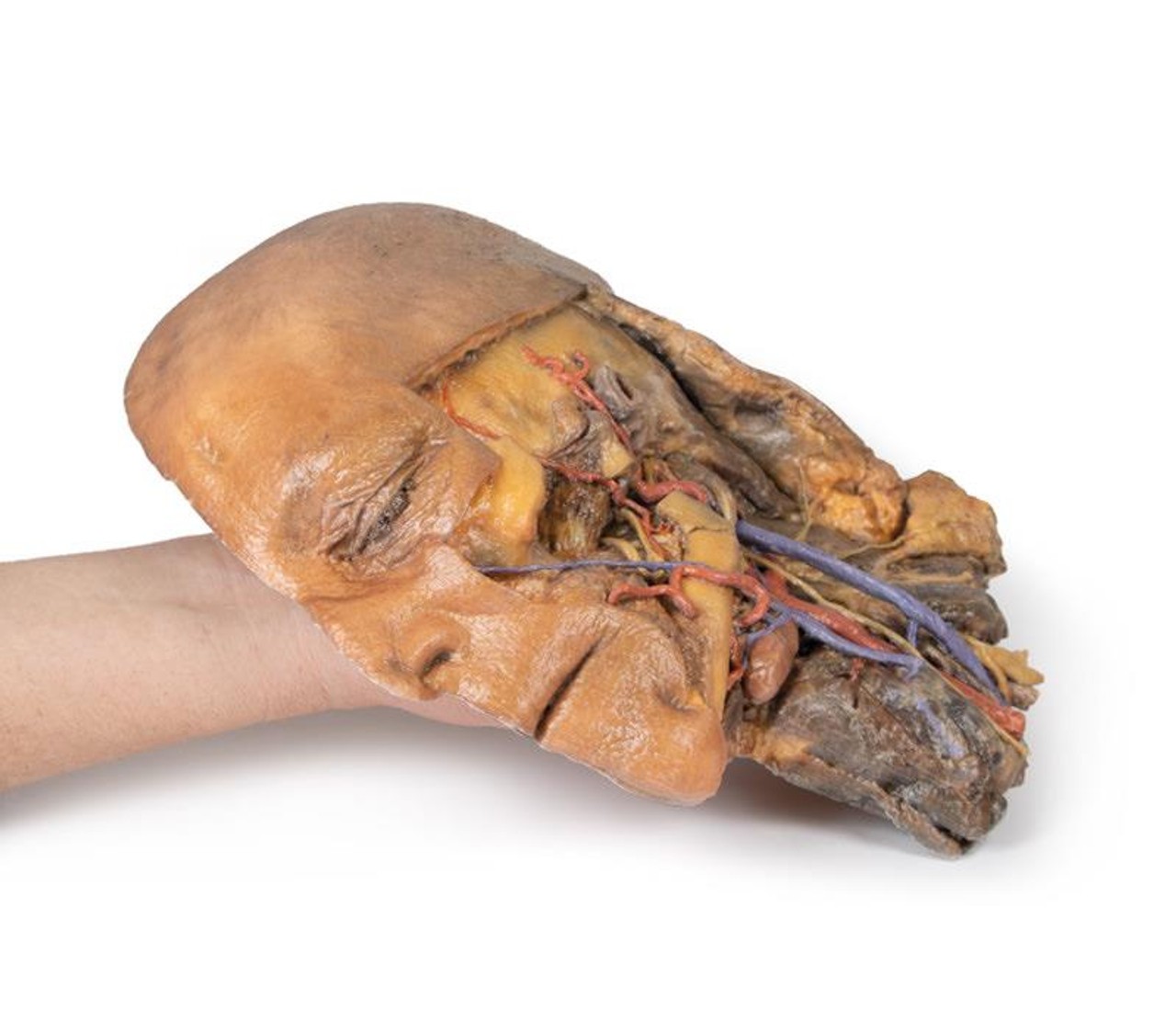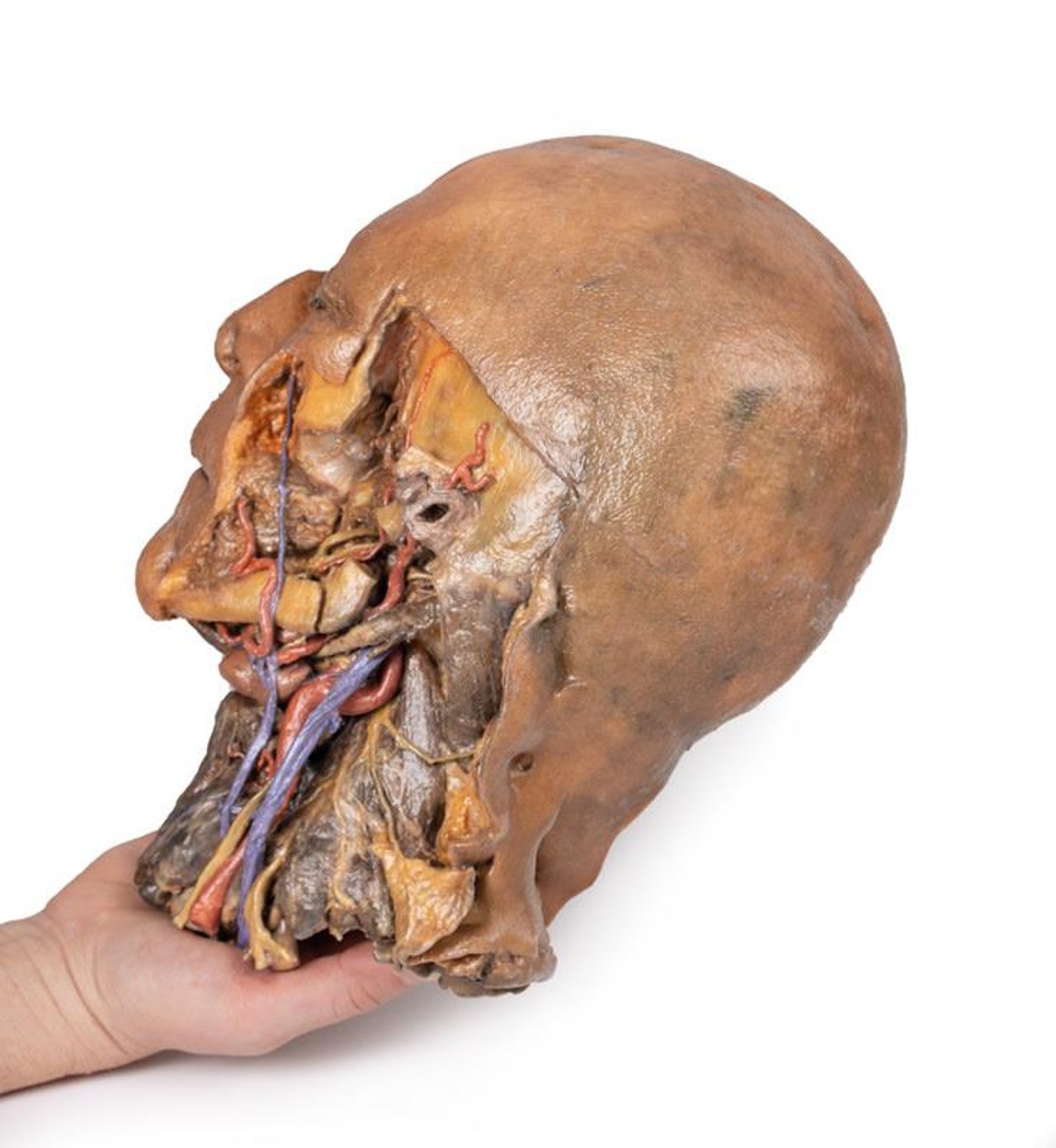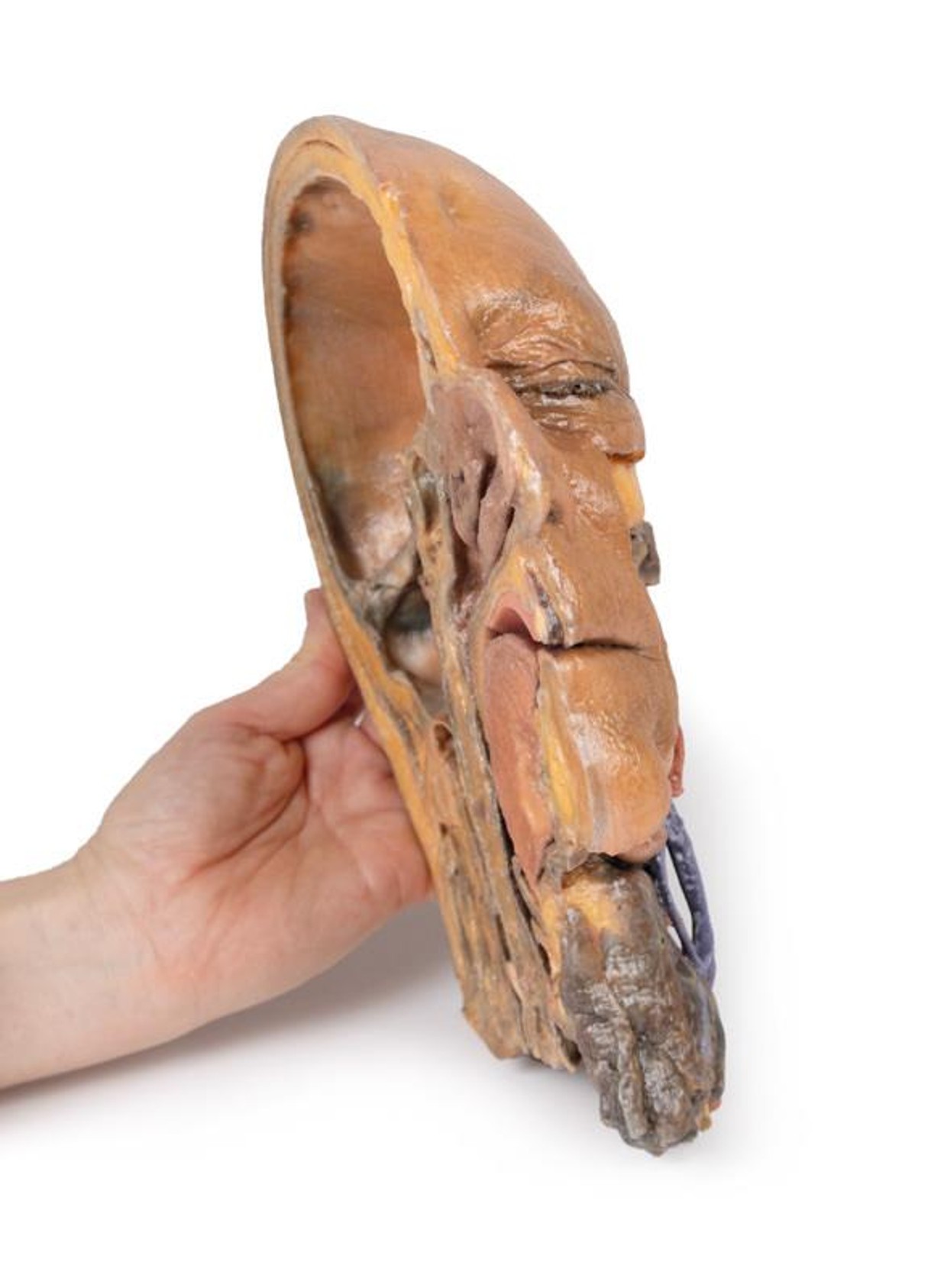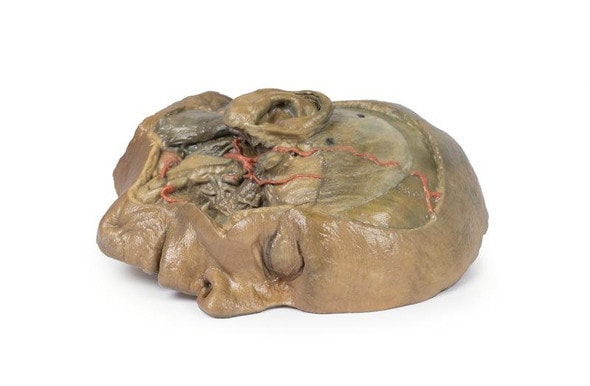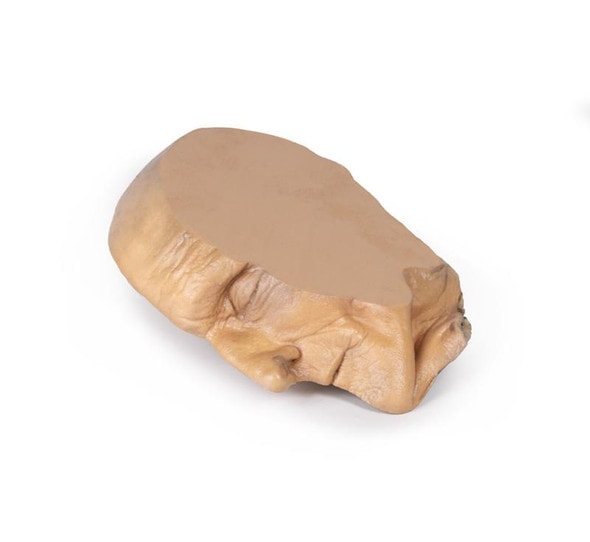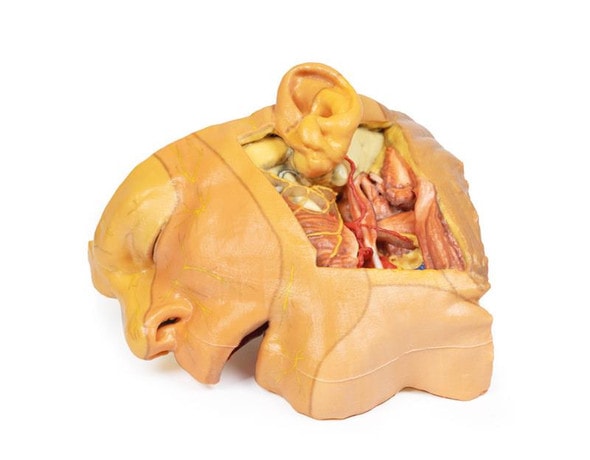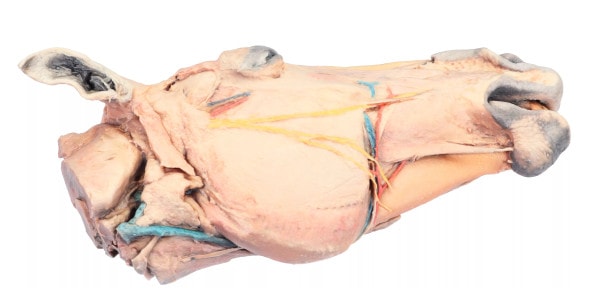- Home
- Anatomy Models
- Head & Neck Anatomy Models
- 3D Printed Sagittal Section of Head and Neck with Infratemporal Fossa and Carotid Sheath Dissection
Description
This 3D model provides a complimentary specimen to the H11 and H12 head and neck specimens by providing a perspective of the endocranial cavity without the brain, and a lateral dissection inclusive of neck anatomy.
In the midsagittal section, the removal of the brain (and reflection of the medulla oblongata inferiorly) affords a full view of the dura mater lining the endocranial cavity, including the tentorium cerebelli spanning from the transverse sinus to the attachment to the clinoid process of the sphenoid. A series of cranial nerves, including the optic (CN II), oculomotor (CN III), trigeminal (CN V), the abducens (CN VI) and the combined facial (CN VII) and vestibulocochlear (CN VIII) nerves can be seen piercing the dura. The pituitary gland can be seen in cross-section within the sella turcica, and the left vertebral artery can be seen ascending in the posterior cranial fossa.
The lateral dissection to the face has retained some superficial structures while simultaneously exposing the anatomy within the infratemporal fossa. The facial vein and facial artery have been preserved but are dissected away from any superficial fascia or muscles of facial expression and lie across the corpus of the mandible and buccinator muscle. Most of the ascending ramus of the mandible and the zygomatic arch have been removed to demonstrate some of the infratemporal fossa anatomy, including the inferior alveolar artery and nerve and lingual nerve (resting on the medial pterygoid), the posterior deep temporal artery (resting on the lateral pterygoid), and the articulation of the mandibular condyle with the glenoid fossa. The terminal part of the external carotid artery is visible, as is the first part of the maxillary artery and the superficial temporal artery.
Posterior to the infratemporal region, the facial nerve (CN VII) can be seen briefly adjacent to the posterior belly of the digastric muscle. The posterior belly of the digastric angles superficially to obscure the internal and external carotid arteries and the internal jugular vein, which have been dissected from the carotid sheath (alongside the vagus nerve [CN X]). At the angle of the mandible, and along the inferior margin of the corpus, the hypoglossal nerve (CN XII) rests just adjacent to the central tendon of the digastric and the external carotid artery. Anteriorly, the facial artery is integrated into the submandibular gland before ascending across the mandibular corpus, where the lingual artery and anterior belly of the digastric can be observed. A set of superficial veins descend inferiorly into the neck as a presumptive external jugular vein (although displaced given the removal of the retromandibular vein and sternocleidomastoid muscle, it is too posterior to be an anterior jugular vein).
In the neck region of the specimen, the hyoid bone is immediately deep to the submandibular gland and receives infrahyoid muscles just superficial to a robust thyroid gland. At the cut section of the dissection inferiorly, the underlying larynx can also be observed. Posterior to the carotid sheath structures, radiating cutaneous branches from the cervical plexus rest on the scalene muscles, and near the inferior margin of the specimen the upper roots of the brachial plexus are preserved adjacent to the exposed internal jugular vein.
Advantages of 3D Printed Anatomical Models
- 3D printed anatomical models are the most anatomically accurate examples of human anatomy because they are based on real human specimens.
- Avoid the ethical complications and complex handling, storage, and documentation requirements with 3D printed models when compared to human cadaveric specimens.
- 3D printed anatomy models are far less expensive than real human cadaveric specimens.
- Reproducibility and consistency allow for standardization of education and faster availability of models when you need them.
- Customization options are available for specific applications or educational needs. Enlargement, highlighting of specific anatomical structures, cutaway views, and more are just some of the customizations available.
Disadvantages of Human Cadavers
- Access to cadavers can be problematic and ethical complications are hard to avoid. Many countries cannot access cadavers for cultural and religious reasons.
- Human cadavers are costly to procure and require expensive storage facilities and dedicated staff to maintain them. Maintenance of the facility alone is costly.
- The cost to develop a cadaver lab or plastination technique is extremely high. Those funds could purchase hundreds of easy to handle, realistic 3D printed anatomical replicas.
- Wet specimens cannot be used in uncertified labs. Certification is expensive and time-consuming.
- Exposure to preservation fluids and chemicals is known to cause long-term health problems for lab workers and students. 3D printed anatomical replicas are safe to handle without any special equipment.
- Lack of reuse and reproducibility. If a dissection mistake is made, a new specimen has to be used and students have to start all over again.
Disadvantages of Plastinated Specimens
- Like real human cadaveric specimens, plastinated models are extremely expensive.
- Plastinated specimens still require real human samples and pose the same ethical issues as real human cadavers.
- The plastination process is extensive and takes months or longer to complete. 3D printed human anatomical models are available in a fraction of the time.
- Plastinated models, like human cadavers, are one of a kind and can only showcase one presentation of human anatomy.
Advanced 3D Printing Techniques for Superior Results
- Vibrant color offering with 10 million colors
- UV-curable inkjet printing
- High quality 3D printing that can create products that are delicate, extremely precise, and incredibly realistic
- To improve durability of fragile, thin, and delicate arteries, veins or vessels, a clear support material is printed in key areas. This makes the models robust so they can be handled by students easily.

